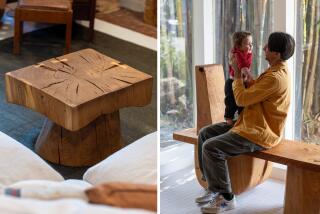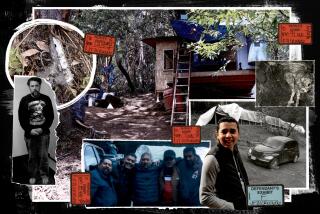Old-World Ways : Tomas Braverman Carries on the Traditions of Spanish Renaissance Furniture Makers
Few furniture makers can make you a wooden bed or table that looks as though it was carved in Renaissance Spain. Tomas Braverman can. Even museum curators might need to blink twice before realizing that his work is 20th Century. The swashbuckling furls, curlicues and pinnacles of his carving have a strong appeal to show-business folk. Braverman designed and carved the late Rock Hudson’s bed. “He had a very generous attitude to an artist’s creativity,” Braverman says. “He gave me a lot of leeway. He seemed to choose artists whose work he respected and, rather than making them do something that he wanted, said, in effect, ‘Do your thing for me.’ ”
Braverman was given the name Thomas by his parents when he was born in Los Angeles 45 years ago, and he is known to his friends as Tom; but he chose Tomas as his professional name because that is what he was called in Seville, Spain, by the Spanish craftsman who taught him to carve wood like a medieval master.
Most of Braverman’s work is ornately carved in Spanish Renaissance or Mexican Colonial styles. He works in a Spanish-style house, which he built himself, in Topanga Canyon. He has one assistant, Ed Koda, 28; Braverman’s Japanese-born wife, Kiyo, does all the finishing--sanding, lacquering, rubbing with stones. Braverman admits that his work is expensive because it takes a long time to make. A carved table, its top a single slab of oak or walnut, can cost from $3,000 to $8,000.
The son of a sales representative for a large clothing manufacturer, Braverman attended public school in Los Angeles until the 10th grade, then went on to the Black-Foxe Military Academy. “I was a swimmer, and they were recruiting swimmers,” he says. Wasn’t the regimentation of a military school foreign to his artist’s temperament? “I escaped. Do you know how I escaped? By being in the band.” Braverman played the saxophone and the clarinet and did little marching or drilling.
He proceeded to a premed course at Pomona College. After two years there, he was in a serious motorcycle accident. He had six months on his back in a hospital to contemplate his career. He began to think he would like to study art instead of medicine.
Against the wishes of his parents and teachers, he changed majors and began studying art at UCLA. He became especially interested in ceramics--glazes, throwing techniques, design. At the end of his first year at UCLA, a Japanese friend who was a swimming teacher persuaded him to go to Japan. “I didn’t know anyone there. I didn’t know the language. I just went--suddenly.” For $175, he bought a ticket on a Japanese freighter. There were five passengers on board; he was the only American. In the 17 days from Los Angeles to Yokohama, he picked up enough Japanese “to feel free to get off the boat and start walking.”
He visited several Japanese cities and ended up in Kyoto, the center of the arts in Japan. There he met an English potter, John Chappell (since killed in a motorcycle accident), who introduced Braverman to the monks of a small Buddhist temple where rooms were rented at a reasonable rate. Braverman supported himself by teaching English five days a month; the rest of the time, he worked as a potter. He worked outside Kyoto with a folk potter named Hatori Shoju.
After a year and a half, Braverman became homesick. “I was 21. I felt like I should come home and decide if potting was what I really wanted to do. The big problem in my mind was that in America a person who works with his hands is not given the kind of respect that I had found in Japan.” He had no money. He did not want to go back to school because “I knew that once I got on the chain I would continue through and be right back where I started.”
The only thing he was naturally drawn to was carpentry. He thought he would find a carpentry job for a year, get back on his feet financially and then decide whether to continue with pottery. Easier said than done. “There was a building bust; there was no building going on. No one wanted an apprentice; it took too much time to train one.” Braverman rode around on his motorcycle until he found a carpenter at work on a house in Bel-Air. The carpenter, named Robert Taylor, said there was no work but asked him to return in a week. Braverman returned, but there was still no work. But the third time he went back, Taylor said: “Son, I want you to go out and buy a nail-apron and a hammer, and come back tomorrow morning. You’ve got a job.”
Braverman knew little about carpentry except what he had learned as a youngster doing chores around his parents’ house. He worked for Taylor for two years. After that, he could get a job with any crew in town, and he worked for one contractor after another, building homes. “The men I worked with were mostly veterans of the Korean War; all they talked about was hunting and fishing and you-know-what.”
After five years of building homes, Braverman found work in a cabinet shop. He also started designing furniture for a house he had rented in Topanga Canyon (next door to where he now lives). One of the pieces turned out especially well, so he took it to a decorator, who said, “Can you do two more for me?” And when Braverman delivered the two pieces, the decorator asked for three more. “That’s how I started as an independent furniture maker.”
In 1968, Braverman decided to spend some time in Seville so that he could study the ornate carved furniture in the museums. On his second day, he noticed a pair of carved wooden doors on one of the government buildings. “They were beautifully carved in Spanish Renaissance style,” he remembers. “I just fell in love with them and spent three hours looking at them.”
A young Spaniard who had been sitting in a cafe nearby came over to Braverman and said: “I’ve never seen anybody look at these doors or any piece of art over here so much. I am curious. Where are you from and why are you here?” The Spaniard had studied at Oxford and spoke good English. He said he wanted to help Braverman. The next morning, he came to Braverman’s hotel and said, “I’m going to take you to my personal furniture maker’s home. I am from one of the old Sevillian families. We are wealthy, and this furniture maker, Antonio Rodriguez Garcia, has worked for us for years. I want to see if he will teach you.”
Garcia was 60--a small, gray-haired man bent over his workbench. “He was quite shocked when we came in the door,” Braverman recalls. “I think he was frightened; he’d never talked with a foreigner before. And he was a very humble and lovely man.” The rich young Spaniard said: “This is Thomas Braverman from the United States, and he wants to learn how to carve. Will you teach him?”
Garcia said, “No. I’ve never taught anyone, and besides, I don’t speak English.” But Braverman, because of his friendship with a Mexican wood carver in Los Angeles, had learned to speak a Mexican street-Spanish, full of idiomatic phrases; and he knew the Spanish names of all the woodworking tools. So Garcia lost his fear and agreed to teach him. Braverman studied under Garcia for two months.
In 1969, Braverman was flooded out of his Topanga house and workshop. Most of his seasoned wood and his tools were washed away. His mother lent him enough money to buy a plot on higher ground in the canyon, and Robert Taylor, his first woodworking mentor, came out of retirement to help him build his present house and workshop.
Kiyo, Braverman’s wife, has become an increasingly important part of the operation. He met her in 1971 while taking a Spanish class at UCLA. She was working for Varig, the Brazilian airline. She spoke good Spanish in addition to Portuguese and was in the class only to keep a girlfriend company. “She brought back happy memories of Japan,” Braverman recalls, “but when she spoke Spanish, that did it.” They were married in 1972 and have a 2-year-old daughter, Mia. At first, Kiyo thought that she could never get interested in his work. But she found she enjoyed finishing his pieces. “You really can see the difference,” she says. “Some people might think you’re sanding for nothing, but it isn’t so. After I’ve worked on the wood, I can see something I couldn’t see before.”
More to Read
The biggest entertainment stories
Get our big stories about Hollywood, film, television, music, arts, culture and more right in your inbox as soon as they publish.
You may occasionally receive promotional content from the Los Angeles Times.










